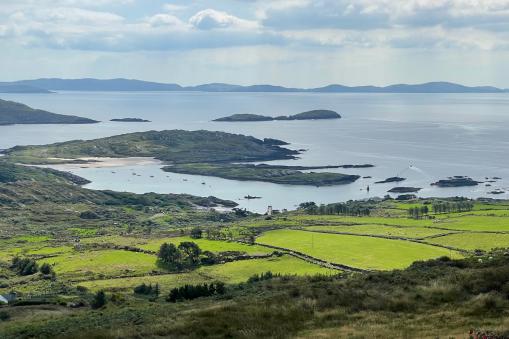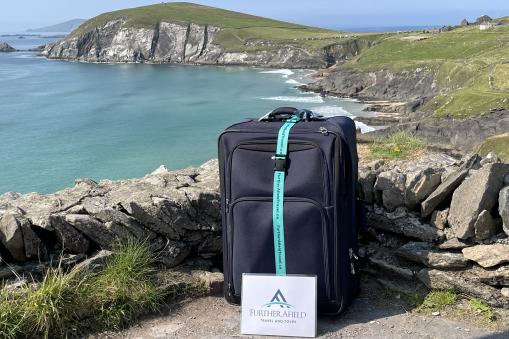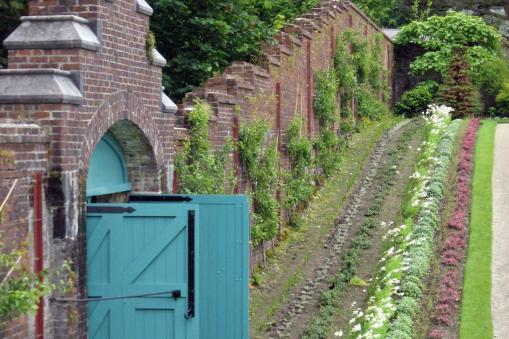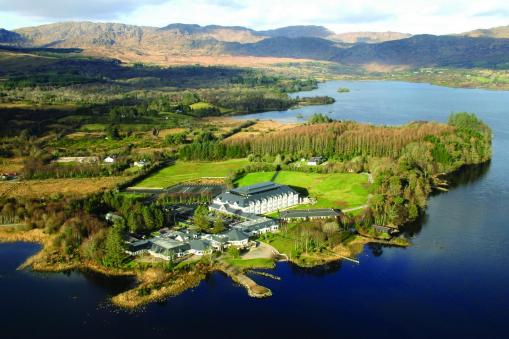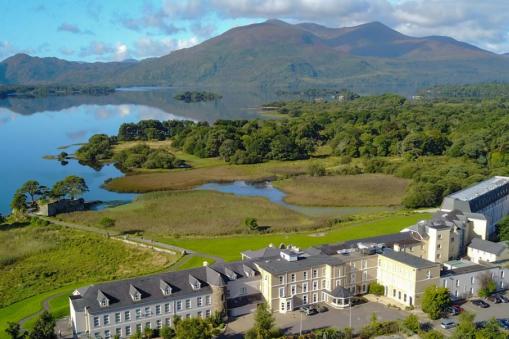Become a part of your journey
You are here
Further Afield's Journal
The Travel Nook
Driving The Ring of Kerry
The drive around the Iveragh Peninsula is known as the ‘Ring of Kerry’. The journey is 160 km of breathtaking scenery. You’ll experience 10,000 years of legends and folklore etched into the landscape.
Ring of Kerry
Travel Insights Taking That First Trip
Sharing with our clients and friends what it is like to take that first post covid trip. We were a bit anxious with all of the rules and regulations and the concern we would be safe. I lost a few nights sleep, but once I felt we had properly prepared for the journey, I was confident that we would enjoy our first trip abroad and keep ourselves safe.
Off to Ireland,
To begin, we needed to navigate the entry requirements and health regulations of the country. Valid passport required. With the passport sitting in the drawer for 18+ months, I blew off the dust and checked that it had not expired. To enter Ireland, a new requirement is the passenger locator form. This is something which appears to have become a common requirement for many destinations, including travel within Canada. As an example, if you were planning to enter Newfoundland, you would need to complete the government entry form.
Next consideration was the health regulations for entering the country. My partner and I are fully vaccinated, however there was a small glitch. I having two doses of Pfizer and he having the mixed vaccines. Ireland does not currently recognize the mixed doses which meant he was not consider fully vaccinated. There are some countries in Europe that accept the mixed doses of vaccination. I expect the Canadian government (as we are already seeing in some of our provinces) may provide a third vaccine dose to those who received the mixed doses. We were not about to give up on our travel plans. To enter Ireland, not being considered fully vaccinated, my partner had to take a covid test prior to departing Canada and upon arrival into Ireland, he had to self-quarantined and take another covid test on day 5. (I having been fully vaccinated with two doses of Pfizer meant, I had no restrictions upon arrival). All fine on day 5 and together we began our journey. Just for the note; as of August 20th, HSE confirms that 85% of Ireland’s population is fully vaccinated and they are now vaccinating children 12 years of age and up.
As the world is learning to manage covid-19, travel restrictions are easing and there will be less barriers as the world reopens. If you plan to travel, we strongly recommend you only do so once you are fully vaccinated. I am also optimistic that we will see more acceptance of the mixed vaccines as restrictions ease.
As we packed for the trip, we included ‘on the go – disinfecting wipes’, plenty of hand sanitizer and face masks. We have very comfortable material 3-layer face masks, but for the journey abroad, we purchased a stock of 4-layer disposable mask that fit well around the face and are very comfortable.
Off to the airport. We checked in online and printed our boarding passes in advance. I had heard the airports were quite busy so I gave ourselves extra time. It was unusually quiet in the airport and with having printed our boarding pass in advance, a simple scan of the boarding pass, and a scan of our passport, the kiosk was able to print out the baggage tags. After attaching the luggage tag, we placed our luggage on the baggage belt, the bags were scanned and we were ready to go through security. There was no need to engage with anyone and very few touch points. While there were plenty of airline staff available should you have any questions or need help.
Security was a breeze. Social distancing was maintained and perspex screens were in place. Everyone was wearing a mask (children exempt) You were still required to have any liquids in a clear bag and place your computer or tablet separate from your other belongings. It all felt very familiar.
We chose to visit the airport lounge in anticipation the airport might be busy. (you can purchase a pass) It’s a quieter area in the airport which offered great social distancing. We felt very comfortable. About an hour prior to our flight departure, we made our way to the gate. Where did all these people come from? With the airport boarding area being as large as it is, we still were able to find a position and maintain social distancing. When we began to board, the process was quick however the people felt a little closer than the 6 feet. Just as we experience in the grocery store, there will always be some in which they believe the rules do not apply. I am certain I was holding my breath. Once at our seats, I pulled out the ‘on-the-go disinfecting wipes and wiped down the seat handles and tray tables. The airlines have done an incredible job disinfecting the plane prior to boarding, but giving everything an extra wipe was no harm.
While on the plane, it was mandatory to wear your mask. (If I forgot to mention, you must wear your mask throughout the airport) Not all masks are accepted and I have heard a number of airlines now insisting on specific types of masks. I overhead the flight attendant advising one person on the plane, that the mask they were wearing was not allowed and they were provided with an approved mask. During meal service, food was served in packaging which enabled less handling. People were able to take off their masks while they ate. I found myself not wanting to remove my masks and chose to not eat. The flight is 6.5 hours, so a second meal service (breakfast) was served. This time I chose to wait until most had eaten and their masks were back on. I removed my mask for as little time as possible. I changed my mask about 4 hours into the flight and it felt very refreshing. My tip to those flying would be to take extra masks with you on the plane and change them every 4 hours. You will thank me later.
Our journey begins….
Hand sanitizing stations are everyone – hand sanitizing at the entry of all hotels, reception counter, and areas of touch points. Some of the hotels had hand sanitizing stations in the elevators, while most restaurants had hand sanitizer on the tables. The best one was the hand sanitizing station fixed to the back of the ‘jaunting cars’ (horse and trap).
Perspex was at the hotel reception counters, concierge desks, and in a number of the restaurants and bars. Large areas did not have perspex, but tables were placed with good social distancing. The hotels screened for covid symptoms. A couple of hotels have taken our temperature upon check in and all have asked us to either complete a health questionnaire in advance or asked us upon arrival.
Dining in the restaurant/pub indoors required proof of vaccination. If you were not fully vaccinated or did not have your ‘proof of vaccination’ with you, you would not be allowed into the restaurant and your option for dining was on the outdoor patio. If you were staying at a hotel, you were not required to show proof for indoor dining. Children who could not be vaccinated were exempt. The breakfast buffet existed, however the staff served you and social distancing was maintained.
Hotel rooms were disinfected before you checked in. You were given the option of having the staff clean your room daily. If you prefer not to have housekeeping enter your room, they would provide fresh towels and toiletries outside your door.
It was very reassuring the measures taken and in place at the hotels and restaurants/pubs to ensure everyone’s safety. We also appreciated being asked for our vaccine certificates, emphasizing they were following protocols. It was comfortable dining indoors knowing that those around us were fully vaccinated.
Is travel back? The hotels, restaurants/pubs were very busy. The weather was beautiful and predominantly the guests/clients were locals enjoying a ‘staycation’. Multi-generational family groups, couples and solos. Similar to us seeing many Canadians travelling in our own country. In Ireland, there are many family-owned hotels and restaurants – the boom of the staycation has seen these establishments through the challenging times. Speaking with staff, the return of the international traveller from Europe, Canada and America has started to take off. While not everyone is ready to venture abroad, it’s great to see people having confidence to travel again.
The workforce of the hospitality sector has not fully returned. During the challenging times of covid, some of the workforce have chosen new career paths. Speaking with a number of hotels and restaurants/pubs, 80% of staff have returned and new hires are taking place. Most attractions are open, but not all – some with capacity and reduced visiting hours. Music in the pubs has not yet returned, however the government is expected to relax the regulations further to allow the return of the musicians. The government has announced that live events will return, being phased in during the months of September and October. This did not impede our enjoyment. We missed the music in the pubs, however the atmosphere still had a great vibe. A bit of patience was well worth the exemplary service provided. For the 2022 season, all hotels, restaurants/pubs and attractions expect to be operating at full capacity.
Ireland affords a great experience with so much to offer. The flight is relatively short (6.5 hours) and there’s a wonderful Fáilte (welcome) from the local people. There is plenty to do with a choice of activities for everyone. The food is fabulous, jaw-dropping scenery, with wide open spaces, intertwined with incredible culture. Ireland is a great choice for those considering travel beyond Canada. Further Afield Travel and Tours has earned the reputation of being Ireland specialists. In addition to arranging individual trips to Ireland, we bring a number of small group tours which are limited to 22 guests. Most of our clients reside in the Greater Toronto area (Oakville, Burlington). We take you to many of our favourite places in Ireland and stay in wonderful hotels and often include a castle stay on our itineraries. We have our 2022 tours posted on our website. Space is limited. Give us a call if you are interested.
If there is another destination in mind, speak with one of our travel professionals. We are a full-service travel agency with valued contacts and preferred partnerships to many regions of the world.
Stay tuned for our next update. Speaking with the local people.
Follow us on Facebook for photos of our journey of this beautiful country.
www.facebook.com/FurtherAfieldTravel
Stay tuned for our next update. Speaking with the local people.
Walled Gardens of Manor Houses and Castles
I’m walking through the fruit and vegetables section of the supermarket and browsing along, looking at the selections, I wonder, when did all of these become available.
Fruit and Veg have always been on the market. When the export of goods around the world became a trade, the return trip from the Far East, India and such like, brought niceties such as herbs, spices and exotic fruits and vegetables. Not to mention that ‘Parrot’.
Visiting Manor houses and castles, I find myself in a gravitational pull to the walled gardens. Did you notice that these gardens are almost always in a square? Four divisions for crop rotation. A discreet large opening away from the main entrance, this may seem obsolete, but it’s the nerve centre of the garden. While the general public come in at the cash desk. This is where soil and manure, seedlings and plants, tools, wheelbarrows, water hose and insecticides are delivered or taken out. The workshop and for all intents and purposes, a mini-laboratory for the head gardener to experiment with cross pollinating new flowers or plants. Not to mention the kettle for the cuppa tea.
The main wall may be of limestone or granite, faced on the inside with red brick. In a temperate climate, it’s amazing what two or three degrees of heat can do. The brick will retain heat giving an earlier and longer growing season. The walls also give protection from wind, frost and the bane of every gardener’s life, The Rabbit. In the more lavish gardens, there were the heated walls. A double wall, with the red brick on the inside. Then very ingeniously, elevated fire places between the walls, with draft openings, moving the heat along and chimneys at the corners to allow the smoke to escape. Everything had to be systematically.
I once asked a retired gentleman gardener, in my innocence, “Was there a particular height that all walls had to be?” “Well, he replied, it all depends on the height of the ‘Rascals’ who are trying to climb over, they would empty a garden overnight”. That ended that conversation.
With the end of the Window Tax in Great Britain and Ireland in 1845, Glasshouses became the desired obsession, for the Grand Houses. These were erected against the south facing walls, with raised beds inside. Vines trees were planted outside the glasshouses and then trained in through the windows and along the rafters. Trimmed to perfection to allow as much sunlight in as possible, for other trees and fruits that were grown in there. Peaches, plums and fig trees, aubergines, peppers, cucumbers, tomatoes, and herbs parsley, thyme, sage and basil. The usual, cabbage, carrots, parsnips, onions, early potatoes.
The main crop of potatoes was grown in the fields, because of the quantity of potatoes needed, and for crop rotation on the farms, cereals; oats, barley and wheat had to be produced.
Kylemore Abbey in Connemara, Co. Galway. Once the residence of Mitchell Henry, his wife and family. They had a most magnificent walled garden, with splendid glasshouses, over 5,000 feet of piping to heat these houses. The Benedictine nuns, bought this property in 1920 and opened a girl boarding school, it continued until 2010. It had a 6-acre garden that was capable of producing enough food to keep the convent and school supplied. With the shortage of labour because of the First World War, the gardens were neglected and over time all but disappeared. The nuns began a restoration project in 1995, with government grant aid and donations from the community. The gardens were reopened in 2000. It’s a fantastic extra included with the tour of Kylemore Abbey. Mainly flowers, plants, shrubs and trees are here today. The head gardener’s house and Bothy (the building for the regular garden workers) have also been restored. The tool shed, showing what these guys had to work with back then. Long hours and dangerous too. Sprays that were being developed and experimented with, were used for pests, fungi bacteria, viruses and insects’ control but were deadly dangerous to humans.
Mildew was a major issue, as was the potato blight which devastated Ireland from 1845-1852. Copper sulphate and washing soda, were discovered by scientists in 1882, a solution that could be sprayed, before the fungus gained root.
Listening to the weather forecast in Ireland, in the month of May or June, farmers are warned that Weather Conditions may be Susceptible to the spread of potato blight. Spraying is needed.
Studies had shown that sprays having been developed were having a detrimental effect on humans and hot-blooded animals.
Muller who had won the Nobel Prize for Medicine, with his manufacturing of DDT during WW II. A chemical that was used the world over. Now outlawed in most countries.
The size of the gardens depended on the size of the estate or what status the owner had in the community or the country. A politician for example would entertain large groups, on many occasions. They had to make an impression, votes may be at stake, or the marriage of a son or daughter, could depend on the spread that was laid out. Choice was a must. A head gardener was a valuable asset, and in big demand, sometimes being encouraged to join another estate. In large estates the gardener had a Villa and perhaps his own servant. Should the Estate owner be a keen gardener and participate in flower or garden exhibits the head gardener would accompany him.
The King Pine. Pineapples were first grown in South America and the Caribbean. When pineapples were first grown in England, it became the centrepiece on the dinner table. Or a lavish array of fruit on a side table, with the pineapple sitting on top, its leaves in a crown like decoration, declaring it King of Fruit.
So famous had it become, that a portrait was commissioned of King Charles II, being presented with a pineapple in 1677 by his gardener, John Rose. By the way. John Rose was also the gardener of Charles’ mistress, the Duchess of Cleveland. Maybe it was symbolic gesture between Charles and the Duchess.
The pineapple has been incorporated into architecture, sculpture, entrances to parks and gardens. On St. Paul’s Cathedral in London, there are two golden statues, not crosses or anything religious but Pineapples.
In literature by Charles Dickens and others, references have been made to King Pine.
I’ll go finish my shopping.
Unique Hotels of Ireland - Harvey's Point
Stories behind our hand-picked Ireland hotels, featuring Harvey's Point, Co. Donegal.
Our tours stay in some of the most unique hotels in Ireland. Learn the story behind the scenes that have lead to the unique and authentic experience these hotels provide our guests.
Featuring Harvey's Point, Co. Donegal
When Jody Gysling came to visit Ireland in the 1980’s from Switzerland he found his paradise in Co. Donegal. Nestled under the Blue Stack Mountains, was a cottage on twenty acres of land, owned by the Harvey brothers, for sale. The task of developing this property into a guest house was gigantic, but rewarding. Having four rooms in 1989 Jody’s friends came for the tranquility, food and wine.
Jody had his brother Mark join him, to now take on the building of an hotel. A wee girl as they say in Donegal was employed for the summer, as receptionist and general employee.
Boy meets girl. Girl meets boy. Deirdre McGlone had no idea at the time that this would be the beginning of a 30 years stay. Having met Mark, teaching him English with a Donegal accent, they fell in love and married in 1996.
Over the years the hotel has expanded to a 64 bedroom, with lodges to facilitate all taste. An exceptional restaurant. Ballroom and conferences centre. Attracting visitors and business to an area with little or no footfall. Employees that have now called Donegal their home from many parts of the world. A major employer in the north west of Ireland, with a staff of 150. Being voted hotel of the year on TripAdvisor for six out of the last seven years.
Sitting on the shores of Lough Eske, adds to this enchanting, romantic, and everlasting, memory of what a holiday should be.
Driving off the main road into what seems like a wilderness and be confronted by “An Aladdin’s Cave of Beauty” is breathtaking.
A drive at twilight, along the lakeshore, with lights dancing through a crochet of patchwork trees of a “Snow White” fairy tale, stirs the heartstrings. That Wow moment, that should be on every tour.
Join Joe and Sandy, from Further Afield Travel and Tours on a journey through Ireland, a Celtic Island steeped in legends, myths and folklore. Come with us for an unforgettable experience, exploring small tows and hidden corners of Ireland. Our groups are limited to 22 guests, so don't delay. Contact us today.
Stories Written Into the Lands - May 9, 2022*
www.furtherafieldtravel.ca/stories-written-land-ireland
Discover Ireland - May 21, 2022
www.furtherafieldtravel.ca/discover-ireland
Best of Ireland - Family - August 12, 2022
www.furtherafieldtravel.ca/best-ireland-family-journey
Signature Ireland - September 19, 2022
www.furtherafieldtravel.ca/ireland-signature
Unique Hotels of Ireland - The Lake Hotel
Owned by the Huggard family since 1940.
The Lake Hotel. Killarney, Co. Kerry.
The Lake hotel in Killarney was a purpose-built hotel back in 1820. Owned by the Huggard family since 1940. Not that this was the now renowned familiar name in the hotel and hospitality first adventure into the hotel business.
Martin Huggard, a farmer in Co. Kerry purchased the Bayview Hotel Waterville in 1912. His wife Mary had been working at the Great Southern Hotel. The Butler Arms in Waterville was added to the portfolio. Anyone visiting here will see references to Walt Disney, who spent time with his long-time friend Charlie Chaplin. He having set up home here for many years.
Through the years Mary’s experience in the hospitality sector was a treasure chest of information for people coming into the business and for the promotion of Irish Tourism. A number of other hotels were added to their list. Family sons and daughters became involved in the business.
The expansion of the Huggard chain of hotels continued. In Cong, Co. Mayo when Noel bought Ashford Castle, previously a home of the Guinness family. A restoration of enormous proportions was needed but none better to take on the onerous challenge. In the neighbouring Co. Galway Ballinahinch Castle was added. This was the home of Richard Martin, one of the famous tribes of Galway and founder of the Society of Prevention of Cruelty to Animals.
Huggards, have celebrated over 100 years in the hotel business. Being the pioneers of an industry that has recognized their achievements and dedication. If one looks at the timeline and the birth of tourism, through a war of independence, a civil war, two world wars, an economic depression, no subsidies or Government grants, credit has to be given and appreciated by those of us who can now reap the rewards for their efforts. Of a family that now sees the third and fourth generations keeping on the business.
The Huggards may have come from France originally and not all of then stayed in Ireland. There are as many as 80 families of Huggard in Canada, mainly in the Province of Ontario. Starting out as farmers but then other businesses, as well as politicians.
A hotel with 131 bedrooms, each having their own specialty. Dining or enjoying a drink with local musicians in the bar of an evening, as you gaze onto the lawn, with the beautiful Lough Leane, hugging the shore line. In the distant background, a silvery moon dances on a clear crystal carpet of water. Deer stroll by at almost arm’s length. Breakfast in the dining room, with a sun kissed mist, above the ripples of a trout stream. The majestic Macgillcuddy Reeks, (mountains) towering in their splendour of sandstone. A symbol of nature’s strength, with the tiny gouged out lakes, left behind as glaciers had sneaked by, millions of years ago.
Take a trip to Ross castle. The home of ‘The O’Donoghue’. Lord of the lands of Kerry. It’s said by many that his ghost lives beneath the waters of Lough Leane and that every seven years on May 1st “La Bealtaine”, the great Celtic feast of Summer, he rises from the waters on his White horse and rides around the lake until the sun has risen to its zenith. Then the gravitational pull draws him back to join the fairies underwater and the other world. Anyone who happens to see him, will have good fortune for the rest of their lives. So be prepared.
The area around The Lake Hotel in Killarney has a plethora of choices for tourists, from water activities, golf, hill walking, mountain climbing, biking, day tours to Dingle or the Ring of Kerry. If you want to chill out and use the leisure facilities, there’s that too.
Exclusive Further Afield Travel and Tours
Maximum 22 people
Stories Written Into the Lands - May 9, 2022
www.furtherafieldtravel.ca/stories-written-land-ireland
Discovery Ireland - May 21, 2022
www.furtherafieldtravel.ca/discover-ireland
Best of Ireland Family - August 12, 2022
www.furtherafieldtravel.ca/best-ireland-family-journey
Signature Ireland - September 19, 2022
www.furtherafieldtravel.ca/ireland-signature
